
Sant Dnyaneshwar, also referred to as Dnyaneshwar, Dnyanadeva, Dnyandev or Mauli or Dnyaneshwar Vitthal Kulkarni (1275–1296), was a 13th-century Indian Marathi saint, poet, philosopher and yogi of the Nath and Varkari tradition. In his short life of 21 years, he authored Dnyaneshwari and Amrutanubhav. These are the oldest surviving literary works in the Marathi language, and considered to be milestones in Marathi literature. Sant Dnyaneshwar's ideas reflect the non-dualistic Advaita Vedanta philosophy and an emphasis on Yoga and bhakti towards Vithoba, an incarnation of Lord Vishnu. His legacy inspired saint-poets such as Eknath and Tukaram, and he is one of the founders of the Varkari (Vithoba-Krishna) Bhakti movement tradition of Hinduism in Maharashtra. Dnyaneshwar undertook samadhi at Alandi in 1296 by entombing himself in an underground chamber.
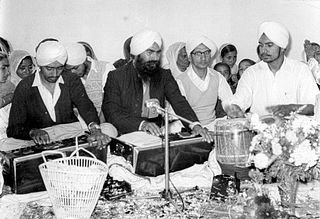
Kirtana, also rendered as Kirtan or Keertan, is a Sanskrit word that means "narrating, reciting, telling, describing" of an idea or story, specifically in Indian religions. It also refers to a genre of religious performance arts, connoting a musical form of narration or shared recitation, particularly of spiritual or religious ideas, native to the Indian subcontinent. A person performing kirtan is known as a kirtankara.

The Dnyaneshwari, also referred to as Jnanesvari, Jnaneshwari or Bhavartha Deepika, is a commentary on the Bhagavad Gita written by the Marathi saint and poet Sant Dnyaneshwar in 1290 CE. Dnyaneshwar lived a short life of 22 years, and this commentary is notable to have been composed in his teens. The text is the oldest surviving literary work in the Marathi language, one that inspired major Bhakti movement saint-poets such as Eknath and Tukaram of the Varkari (Vithoba) tradition. The Dnyaneshwari interprets the Bhagavad Gita in the Advaita Vedanta tradition of Hinduism. The philosophical depth of the text has been praised for its aesthetic as well as scholarly value.

Sant Tukaram Maharaj, also known as Tuka, Tukobaraya, Tukoba, was a Hindu, Marathi Saint of "Varkari sampradaya" in Dehu village, Maharashtra in the 17th century. He was a bhakt of Lord Pandurang of Pandharpur. He is best known for his devotional poetry called Abhanga, which are popular in Maharashtra, many of his poems deals with social reform.
Marathi literature is the body of literature of Marathi, an Indo-Aryan language spoken mainly in the Indian state of Maharashtra and written in the Devanagari and Modi script.

Namdev, also transliterated as Nam Dayv, Namdeo, Namadeva, was a Marathi Vaishnav saint from Narsi, Hingoli, Maharashtra, Medieval India within the Varkari tradition of Hinduism. He lived as a devotee of Lord Vitthal of Pandharpur. He is widely regarded as the founder of Varkari tradition.

Warkari is a sampradaya within the bhakti spiritual tradition of Hinduism, geographically associated with the Indian state of Maharashtra. Warkaris worship Vitthal, the presiding deity of Pandharpur, regarded as a form of Vishnu. Saints and gurus of the bhakti movement associated with the Warkaris include Dnyaneshwar, Namdev, Chokhamela, Eknath, and Tukaram all of whom are accorded the title of Sant. Recent research has suggested that the Varkaris were historically the followers of Krishna.
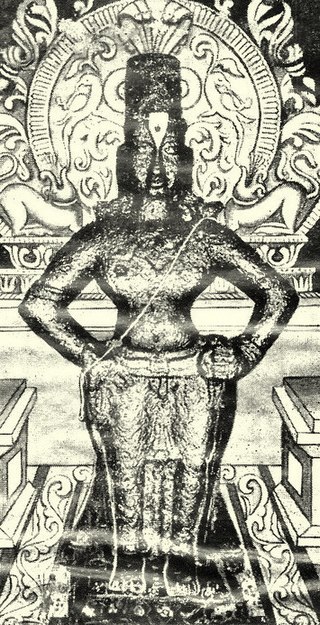
Vithoba, also known as Vitthala, and Panduranga, is a Hindu god predominantly worshipped in the Indian state of Maharashtra and Karnataka. He is a form of the god Vishnu. Vithoba is often depicted as a dark young boy, standing arms akimbo on a brick, sometimes accompanied by his consort Rakhumai.

Chokhamela was a Hindu saint in Maharashtra, India in the 14th century. He belonged to the Mahar caste,, which was considered that time one of the low castes in India. He was born at Mehuna Raja, a village in Deulgaon Raja Taluka of Buldhana district. He lived at Mangalvedha in Maharashtra. He wrote many Abhangas. One of his famous Abhangas is 'Abir Gulal Udhlit Rang". Social activist Arvind Prabhakar Kayande Started Celebrating "Chokhamela Festival" in Deulgaon Raja. He was one of the first low-cast poets in India.

Abhanga is a form of devotional poetry sung in praise of the Hindu god Vitthal, also known as Vithoba. The word "abhang" comes from a for "non-" and bhanga for "ending" or "interrupting", in other words, a flawless, continuous process, in this case referring to a poem. By contrast, the devotional songs known as Bhajans focus on the inward journey. Abhangs are more exuberant expressions of the communitarian experience. Abhanga is considered a form of the ovi. Abhangs are sung during pilgrimage to the temples of Pandharpur, by the devotees.
Sant Janābāi was a Marāthi religious poet in the Hindu tradition in India, who was born likely in the seventh or the eighth decade of the 13th century. She died in 1350.
Visoba Khechara, spelled also as Visoba Khechar or Visoba Khecar, was the yogi-guru of the Varkari poet-saint Namdev (c.1270-1350) of Maharashtra, India. Visoba was a disciple of the Varkari poet-saint Jñāneśvar. He had linkages with the Varkari tradition as well as the Nath tradition of Maharashtra. Though a staunch Shaiva, Visoba has composed verses in praise of the god Vithoba, the patron deity of the Varkari faith. He has also composed a metaphysical treatise called the Shatsthala.

Kanhopatra was a 15th-century Marathi saint-poet, venerated by the Varkari sect of Hinduism.
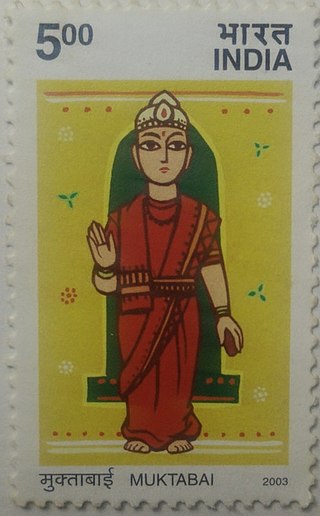
Muktabai or Mukta was a saint in the Varkari Movement. She was born in a Deshastha Brahmin family and was the younger sister of Dnyaneshwar, the first Varkari saint. She wrote forty-one abhangs throughout her life.
Maha Bhakta vijaya is a Marathi text by Mahipati around 1762 that extols the deeds of the saint-poets of the Varkari sect of Hinduism. It has been translated into various languages in India and is widely read. It forms an important part of the prayer for devotees of Vithoba at Pandharpur. An English translation was published under the provisions of the will of Justin E. Abbott in 1933.
Janardan Swami, or simply Janardan or Janardana was an Indian Hindu scholar, statesman, poet and saint. He was the spiritual guru of prominent 16th-century saint Eknath. His compositions were mostly written in Marathi. He also wrote a few verses in Braj.
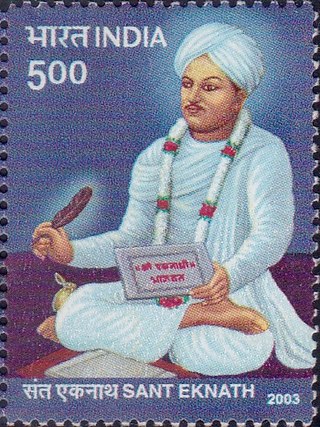
Eknath (1533–1599), was an Indian Hindu saint, philosopher and poet. He was a devotee of the Hindu deity Vitthal and is a major figure of the Warkari movement. Eknath is often viewed as a spiritual successor to the prominent Marathi saints Dnyaneshwar and Namdev.
Narahari Sonar or Narharidas was a 13th-century Hindu poet-saint of the Varkari sect and goldsmith (sonar) from Maharashtra, India. His hagiography speaks about his transition from a staunch Shaiva to a Vithoba-worshipping Varkari after a miracle that makes him realize that Vithoba and Shiva are one and the same.

Sheikh Muhammad (1560–1650), also known as Shekh Mahammad (Mohammad), Sayyad Shaikh Mahammad Qadiri, Shaikh Muhammad Shrigondekar (lit. Sheikh Muhammad of Shrigonde), and Sheikh (Shekh) Mahammad-baba, was a Muslim saint-poet who is venerated by Hindus. He is considered the most well-known Marathi Muslim poet. He is the author of the Yoga-samgrama (Yoga-sangrama).
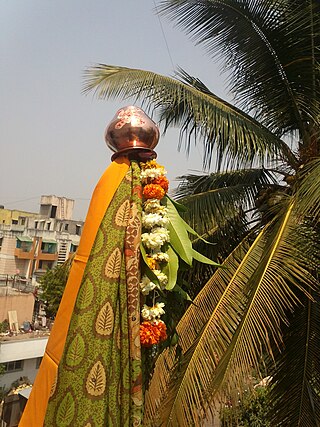
Hindus form 79.83% of the state's total population as per 2011 census. Hindus form the majority in all the districts of the state.The religion plays an important role in the lives of the Maharashtrian people in their day-to-day life. Vitthoba, along with other incarnations of Vishnu such as Rama and Krishna, Hanuman, Dattatreya, and Shaiva deities such as Shiva, Parvati, and Ganesha, are popular with Hindus of Maharashtra. The Varkari tradition holds a strong grip on the local Hindus of Maharashtra. The public Ganesha festival started by Bal Gangadhar Tilak in the late 19th century is very popular. Marathi Hindus also revere Bhakti saints associated with varkari sects such as Dnyaneshwar, Savata Mali, Tukaram, Namdev, Janabai, and Chokhamela. Many religious figures from 19th and 20th century are revered. They include Swami Samarth, Gajanan Maharaj, Sai baba of Shirdi, Tukdoji Maharaj, Gondavalekar Maharaj, and Gadge Maharaj.














